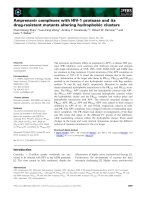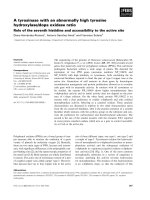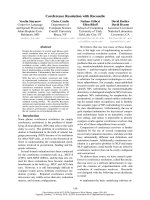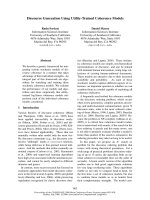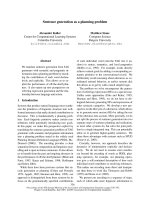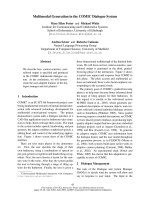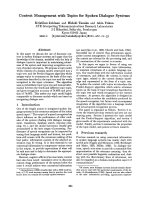Báo cáo khoa học: "Head-Driven Generation with HPSG" pdf
Bạn đang xem bản rút gọn của tài liệu. Xem và tải ngay bản đầy đủ của tài liệu tại đây (426.61 KB, 5 trang )
Head-Driven Generation with HPSG
Graham Wilcock*
Centre for Computational Linguistics
University of Manchester Institute
of Science and Technology
PO Box 88, Manchester M60 1QD
United Kingdom
graham©ccl, umi st. ac. uk
Yuji Matsumoto
Graduate School of Information Science
Nara Institute of Science and Technology
8916-5 Takayama, Ikoma, Nara 630-01
Japan
matsu~is, aist-nara, ac. j p
Abstract
As HPSG is head-driven, with clear semantic heads,
semantic head-driven generation should be simple.
We adapt van Noord's Prolog generator for use with
an HPSG grammar in ProFIT. However, quantifiers
and context factors are difficult to include in head-
driven generation. We must adopt recent theoretical
proposals for lexicalized scoping and context. With
these revisions, head-driven generation with HPSG
is not so simple, but it is possible.
1 Introduction
A natural approach to generation with Head-driven
Phrase Structure Grammar (Pollard and Sag, 1994)
is to use a head-driven algorithm. HPSG is head-
driven not only syntactically, but also semantically.
While the Head Feature Principle requires identity
of major syntactic features between a phrase and
its syntactic head daughter, the Semantics Principle
(in various formulations) requires identity of major
semantic features between a phrase and its seman-
tic head daughter. Since the semantic head is very
clearly defined in HPSG, semantic head-driven gen-
eration should be easy to implement.
Efficient head-driven generation algorithms, such
as BUG, SHD and CSHD, have been presented as
Prolog algorithms for use with DCG grammars. In
Section 2 we briefly describe how an HPSG grammar
can be implemented as a PSG with typed feature
structures, which can be compiled into a DCG by
the ProFIT system. In this way, HPSG grammars
can be used with the existing Prolog algorithms.
Such a combination of head-driven grammar and
head-driven generator works well if the semantics is
strictly head-driven. However, in Section 3 we show
that if we implement the HPSG textbook semantics,
with quantifier storage and contextual background
conditions, the notion of semantic head becomes un-
clear and this approach no longer works. In fact,
head-driven generation of even simple phrases such
" Visiting researcher of Sharp Corporation, Japan.
as "Kim walks" (Chapter 1 of the HPSG textbook)
raises fundamental difficulties.
To use a semantic head-driven algorithm, we must
adopt recent HPSG proposals to put quantifier store
and contextual background inside semantic heads.
We summarize these proposals in Section 4, and
show how they can be implemented in the ProFIT
HPSG grammar. We conclude that head-driven gen-
eration with HPSG is possible, but there are some
difficulties in implementing this approach.
2 Head-Driven Generation
We assume that generation starts from logical forms,
which may be represented for HPSG as typed feature
structures. Logical form is not a separate linguistic
level in HPSG, but is equated with semantic content.
In this section, we take the starting logical form for
generation to be a semantic feature structure which
will be identical to the CONTENT feature of the
top-level HPSG sign to be generated.
2.1 Semantic heads
Head-driven generation algorithms are based on the
idea that most grammar rules have a semantic head
daughter whose logical form is identical to the logi-
cal form of the mother. The bottom-up generation
(BUG) algorithm of van Noord (1990) requires every
rule to have such a head (except lexical entries). The
semantic head-driven (SHD) algorithm of Shieber et
hi. (1990) relaxes this, dividing rules into chain rules
with such a head (processed bottom-up), and non-
chain rules (processed top-down). The chart-based
semantic head-driven (CSHD) algorithm 1 of Haruno
et al. (1996) increases efficiency by using a chart to
eliminate recomputation of partial results.
Head-driven bottom-up generation is efficient as
it is geared both to the input logical form (head-
driven) and to lexical information (bottom-up). It
is good for HPSG, which is highly lexicalist and has
1For simplicity we illustrate the approach with BUG. A
ProFIT/HPSG framework using the CSHD algorithm is de-
scribed by Wilcock and Matsumoto (1996).
1393
'HFP' := synsem!loc!cat!head!HF k
hd_dtr!synsem!loc!cat!head!HF.
'SemP' := synsem!loc!cont!Cont k
hd_dtr!synsem!loc!cont!Cont.
'SemP'(adjunct) := synsem!loc!cont!Cont
adj_dtr!synsem!loc!cont!Cont.
hd_ph := <hd_ph k
@'HFP' k
synsem!loc!cat!val!comps! Q.
hd_nexus_ph := <hd nexus_ph k @hd ph k @'SemP'.
hdsubj_ph := <hd_subj_ph k @hd_nexus_ph k
@'VALP'(spr) k @'VALP'(comps)
synsem!loc!cat!val!subj![].
hd_comp_ph := <hd_comp_ph k @hd_nexus_ph k
@'VALP'(subj) & @'VALP'(spr).
@hd_subj_phk phon!PO-PN
hd_dtr!(Head k
synsem!loc!ca~!val!subj![S]) k
subj_dtr!(Subj k synsem!S)
> [Head & <phrase k phon!PI-PN,
Subj k <phrase k phon!P0-Pl].
@hd_comp_phk phon!P0-PN k
hd_dtr!(Head &
synsem!loc!cat!val!comps![C]) k
comp_dtrs![Comp k synsem!C]
> [Head & <word a phon!P0-Pl,
Comp a <phrase k phon!PI-PN].
Figure 1: Principles, Phrase Types, Schemata
a clear definition of semantic head: in head-adjunct
phrases, the adjunct daughter is the semantic head;
in other headed phrases, the syntactic head daughter
is the semantic head. In both cases, the Semantics
Principle basically requires the content of the seman-
tic head to be identical to the content of the mother.
If we ignore coordinate structures, and if we equate
logical form with semantic content for now, then all
HPSG grammar rules are SHD chain rules, meeting
the requirement of the BUG algorithm.
2.2 HPSG in ProFIT
ProFIT: Prolog with Features, Inheritance and Tem-
plates (Erbach, 1995) is an extension of Prolog which
supports inheritance-based typed feature structures.
The type hierarchy is declared in a signature, which
defines subtypes and appropriate features of every
type. Terms with typed feature structures can then
be used alongside normal terms. Using the signature
declarations, the ProFIT system compiles the typed
feature structures into normal Prolog terms, which
can be compiled by the Prolog system.
Figure 1 shows some implementation details. We
use ProFIT templates (defined by ':=') for princi-
pies such as the Head Feature Principle ('HFP')
and Semantics Principle ('SemP'). Templates are
expanded where they are invoked (by @'HFP' or
@'SemP'). The type hierarchy includes the phrase
type hierarchy of Sag (1997). As ProFIT does not
support dynamic constraints, we use templates to
specify phrasal constraints. For example, for head-
nexus phrases, the hd__nexus_ph template specifies
the <hd_nexus_ph type, invokes general constraints
on headed phrases (such as HFP) by @hd_ph, and
invokes the Semantics Principle by @'SetuP'.
Immediate dominance schemata are implemented
as PSG rules, using schematic categories
word
and
phrase,
not traditional categories (NP, VP etc). To
simplify the generator, the semantic head is first in
the list of daughters. Linear precedence is speci-
fied by the PHON strings, implemented as Prolog
difference lists. Example rules for Head-Subject and
Head-Complements Schemata are shown in Figure 1.
2.3 HPSG Interface for BUG1
van Noord (1990) implements the BUG algorithm
as BUGI in Prolog. For HPSG, we add the ProFIT
interface in Figure 2. Templates identify the head
features (HF) and logical form (LF), and keep the
algorithm independent from HPSG internal details.
Note that link, used by van Noord (1990) to im-
prove the efficiency of the algorithm, is replaced by
the HPSG Head Feature Principle.
hf(HF) := synsem!loc!cat!head!HF.
If(LF) := synsem!loc!cont!LF.
predict_word(@If(LF) k @hf(HF), Word ) :-
lex( Word t @If(LF) k @hf(HF) ).
predict_rule(Head,Mother,Others,@hf(HF)) :-
( Mother k @hf(HF) > [HeadJOthers] ).
generate(LF, Sign, String) :-
bugl( Sign k phon!String-[] k @If(LF) ).
/* BUGI: van Noord 1990 */
bugl(Node) :-
predict_word(Node, Small),
connect(Small, Node).
connect(Node, Node).
connect(Small, Big) :-
predict-rule(Small'Middle'Others'Big)'
gen_ds(0thers),
connect(Middle, Big).
gen_ds(Q).
gen_ds([Node~Nodes]) :-
bug1(Node),
gen_ds(Nodes).
Figure 2: ProFIT/HPSG Interface for BUG1
1394
S
"PHON
(she, saw, Kim)
[see-rel]
CONT [] SEER
SEEN
[NAME
Kim
N-P
CONT ] INDEX []
BACKGR {~}
VP
'PHON
(saw,
Kim>]
CONT [] |
BACKGR {gl} J
V NP
"PHON
(saw>]
[PHON
]
CONT [] / ] CONTIINDEX [] I
BACKGR {}J [BACKGR {~)J
Figure 3: Contextual Background (Phrasal Amalgamation)
3 Quantifiers and Context
Head-driven generation as in Section 2 works fine if
the semantics is strictly head-driven. All semantic
information must be inside the CONTENT feature,
and cannot be distributed in other features such as
QSTORE or BACKGR. When an NP is assigned to
the semantic role of a verb, the whole of the NP's
CONTENT must be assigned, not only its INDEX.
This differs significantly from HPSG theory.
3.1 Quantifier Storage and Retrieval
There is a complication in Pollard and Sag (1994)
caused by the use of Cooper storage to handle scope
ambiguities. While scoped quantifiers are included
in the QUANTS list within CONTENT, unscoped
quantifiers are stored in the QSTORE set outside
CONTENT. So logical form for generation needs to
include QSTORE as well as CONTENT.
In this approach, a quantifier may be retrieved at
any suitable syntactic node. A quantifier retrieved
at a particular node is a member of the QSTORE
set (but not the QUANTS list) of some daughter of
that node. Due to the retrieval it is a member of
the QUANTS list (but not the QSTORE set) of the
mother node. Pollard and Sag (1994) define a mod-
ified Semantics Principle to cater for this, but the
effect of retrieval on QSTORE and QUANTS means
that the mother and the semantic head daughter
must have different logical forms. The daughter is
the semantic head by the HPSG definition, but not
as required by the generation algorithm.
3.2 Contextual Background
In addition to semantic content, natural language
generation requires presuppositions and other prag-
matic and discourse factors. In HPSG, such factors
are part of CONTEXT. To specify these factors for
generation, the usual approach is to include them in
the logical form. So logical form needs to include
CONTEXT as well as CONTENT and QSTORE.
This extended logical form is defined for BUG1 by
replacing the ProFIT template for 'lf(LF)' shown in
Figure 2 with the new template in Figure 4.
lf(ct!CT ~ qs!OS ~ cx!CX) :=
synsem!loc!(cont!CT & qstore!QS & conx!CX).
Figure 4: Extending the Logical Form
However, head-driven generation does not work
with this inclusive logical form, given the theory of
Pollard and Sag (1994). Even if we ignore quantifier
retrieval and look at a very simple sentence, there is
a fundamental difficulty with CONTEXT.
Figure 3, from Wilcock (1997), shows the HPSG
analysis of
she saw Kim.
Note that
she
has a non-
empty BACKGR set (shown by tag []), stating a
pragmatic requirement that the referent is female.
1395
This background condition is part of CONTEXT,
and is passed up from NP to S by the Principle of
Contextual Consistency. Similarly,
Kim
has a back-
ground condition (shown by tag []) that the referent
bears this name. This is also passed from NP to VP,
and from VP to S.
S, VP and V share the same CONTENT (shown
by tag ill). If logical form is restricted to seman-
tic content as in Figure 2, then V is the semantic
head of VP and VP is the semantic head of S, not
only in terms of the HPSG definition but also in
terms of the BUG algorithm. In this case,
saw
can
be found immediately by predict_word in BUG1.
But if we extend logical form as in Figure 4, to in-
clude the context factors required for adequate re-
alization, it is clear from Figure 3 that S does not
have the same logical form as VP, and VP does not
have the same logical form as V, as their BACKGR
sets differ. Therefore, although V is still the seman-
tic head of VP according to the HPSG definition,
it is not the semantic head according to the BUG
algorithm. Similarly, VP is still the semantic head
of S for HPSG, but it is not the semantic head for
BUG. In this case, predicl;_word cannot find any se-
mantic head word in the lexicon, and BUG1 cannot
generate the sentence.
4 Revising the Grammar
If we include unscoped quantifiers and contextual
background in logical form, we see that there are two
different definitions of "semantic head": the HPSG
definition based on adjunct daughter or syntactic
head daughter, and the BUG algorithm definition
based on identity of logical forms. However, recent
proposals for changes in HPSG theory suggest that
the two notions of semantic head can be brought
back together.
4.1 Lexical amalgamation in HPSG
In Pollard and Sag (1994), QSTORE and BACKGR
sets are
phrasally amalgamated.
The Quantifier In-
heritance Principle requires a phrase's QSTORE to
be the set union of the QSTOREs of all daughters,
minus any quantifiers in the phrase's RETRIEVED
list. The Principle of Contextual Consistency re-
quires a phrase's BACKGR to be the set union of
the BACKGR sets of all the daughters.
It has recently been proposed that these sets
should be
lezically amalgamated.
A syntactic head
word's arguments are now lexically specified in its
ARGUMENT-STRUCTURE list. The word's set-
valued features can therefore be defined in terms of
the amalgamation of the set-valued features of its
arguments.
Lexical amalgamation of quantifier storage was
proposed by Pollard and Yoo (1995). They change
QSTORE into a local feature which can be included
in the features subcategorized for by a lexical head,
and can therefore be lexically amalgamated in the
head. A phrase no longer inherits unscoped quan-
tifiers directly from all daughters, instead they are
inherited indirectly via the semantic head daughter.
Lexical amalgamation of CONTEXT, proposed
by Wilcock (1997), follows the same approach. As
CONTEXT is a local feature, it can be subcatego-
rized for by a head word and lexically amalgamated
in the head by means of a BACKGR amalgamation
constraint. Instead of a phrase inheriting BACKGR
conditions directly from all daughters by the Prin-
ciple of Contextual Consistency, they are inherited
indirectly via the "contextual head" daughter which
is the same as the semantic head daughter.
4.2 Lexical amalgamation in ProFIT
In the ProFIT implementation, QSTORE sets and
BACKGR sets are Prolog difference lists. Lexical
amalgamation of both sets is shown in Figure 5,
the lexical entry for the verb "saw". The subject's
BACKGR set B0-B1 and the object's BACKGR set
B1-BN are amalgamated in the verb's BACKGR set
B0-BN. The subject and object QSTORE sets, Q0-
Q1 and Q1-QN, are similarly amalgamated in the
verb's QSTORE Q0-QN.
lex( phon![sawlX]-X & @verb &
synsem!loc!(
cat!(head!<verb &
val!(subj![@np &
loc!(cat!head!case!<nom
cont!index!Subj &
conx!backgr!BO-Bl &
qstore!QO-Ql)] &
comps![@np &
loc!(cat!head!case!<acc
cont!index!Obj
conx!backgr!Bi-BN &
qstore!QI-QN)])) &
cont!nuc!(seer!Subj & seen!Obj) &
conx!backgr!BO-BN
qstore!QO-QN) ).
Figure 5: Lexical amalgamation
The basic Semantics Principle, for semantic con-
tent only, was implemented by the ProFIT templates
'SemP' and 'SemP'(adjunct) as shown in Figure 1.
In order to include unscoped quantifiers and back-
ground conditions in logical form, as in Figure 4,
and still make it possible for the logical form of
a phrase to be identical to the logical form of its
1396
semantic head, the Semantics Principle is replaced
and extended. As proposed by Wilcock (1997), we
need three principles: Semantic Head Inheritance
Principle (SHIP), Quantifier Inheritance Principle
(QUIP), and Contextual Head Inheritance Princi-
ple (CHIP). These are implemented by templates as
shown in Figure 6 (only the non-adjunct forms are
shown). To include the three principles in the gram-
mar, the template for hd_nexus_ph in Figure 1 is
extended as shown in Figure 6.
'SHIP'
:=
synsem!loc!cont!Cont &
hd_dtr!synsem!loc!cont!Cont.
'QUIP' := synsem!loc!qstore!QS
k
hd_dtr!synsem!loc!qstore!QS.
'CHIP' := synsem!loc!conx!Conx
k
hd_dtr!synsem!loc!conx!Conx.
hd_nexus_ph := <hd_nexus_ph & @hd_ph k
@'SHIP' & @'QUIP' & Q'CHIP',
Figure 6: Inheritance of Logical Form
With these revisions, it is possible to include
unscoped quantifiers and background conditions in
the starting logical form, and perform head-driven
generation successfully using the BUG1 generator.
However, there remain various technical difficulties
in this implementation. The ProFIT system does
not support either dynamic constraint checking or
set-valued features. The methods shown (template
expansion and difference lists) are only partial sub-
stitutes for the required facilities.
5
Conclusion
The combination of a head-driven HPSG grammar
with a head-driven generation algorithm is a natu-
ral approach to surface realization. We showed how
van Noord's BUG1 generator can easily be adapted
for use with an HPSG grammar implemented in
ProFIT, and that this works well if the semantics is
strictly head-driven. However, while the apparently
clear definition of semantic head in HPSG should
make semantic head-driven generation easy to imple-
ment, we found that if we implement the full HPSG
textbook semantics, with quantifier storage and con-
textual background conditions, the notion of seman-
tic head becomes unclear. Surprisingly, this natural
approach does not work, even for simple examples.
In order to use semantic head-driven generation
algorithms with HPSG, we must adopt recent pro-
posals to include quantifier storage and contextual
background inside semantic heads by means of lex-
ical amalgamation. We showed how the grammar
in ProFIT can be extended with these proposals.
We therefore conclude that head-driven generation
with HPSG is indeed a feasible approach to surface
realization, although there are some technical diffi-
culties.
Acknowledgements
We are grateful to Mr Yoshikazu Nakagawa of Sharp
Corporation for making our collaboration possible.
References
Gregor Erbach. 1995. ProFIT: Prolog with Fea-
tures, Inheritance, and Templates. In Seventh
Conference of ~he European Chapter of the Asso-
ciation for Computational Linguistics, pages 180-
187, Dublin.
Masahiko Haruno, Yasuharu Den, and Yuji Matsu-
moto. 1996. A chart-based semantic head driven
generation algorithm. In G. Adorni and M. Zock,
editors, Trends in Natural Language Generation:
An Artificial Intelligence Perspective, pages 300-
313. Springer.
Carl Pollard and Ivan A. Sag. 1994. Head-driven
Phrase Structure Grammar. CSLI Publications
and University of Chicago Press.
Carl Pollard and Eun Jung Yoo. 1995. Quantifiers,
wh-phrases and a theory of argument selection.
Tiibingen HPSG workshop.
Ivan A. Sag. 1997. English relative clause construc-
tions. Journal of Linguistics, 33(2):431-484.
Stuart M. Shieber, Gertjan van Noord, Fer-
nando C.N. Pereira, and Robert C. Moore. 1990.
Semantic head-driven generation. Computational
Linguistics, 16(1):30-42.
Gertjan van Noord. 1990. An overview of head-
driven bottom-up generation. In R. Dale, C. Mel-
lish, and M. Zock, editors, Current Research
in Natural Language Generation, pages 141-165.
Academic Press.
Graham Wilcock and Yuji Matsumoto. 1996. Re-
versible delayed lexical choice in a bidirectional
framework. In 16th International Conference on
Computational Linguistics (COLING-96), pages
758-763, Copenhagen.
Graham Wilcock. 1997. Lexicalization of Context.
4th International Conference on HPSG, Ithaca. To
appear in G. Webelhuth, J P. Koenig and A. Kat-
hol, editors, Lexical and Constructional Aspects of
Linguistic Explanation. CSLI Publications.
1397
